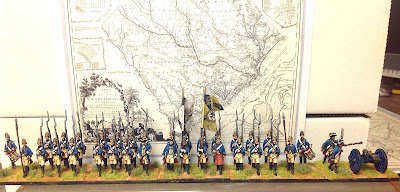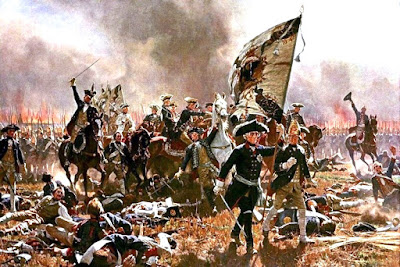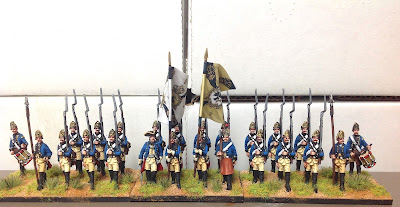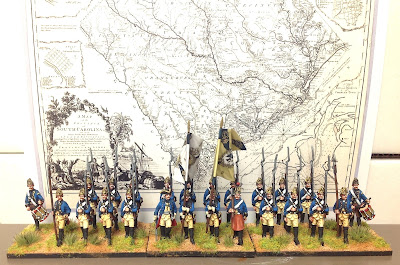 |
| IR46 von Bulow Fusiliers |
CLICK ON ALL PICTURES TO ENLARGE
The first battalion of IR46 von Bulow went into service in my Pomeranian Army yesterday. The actual painting was completed two days ago, but battalions and cavalry regiments do not enter service until they are flagged and based with terrain, tufts and static grass.
The first picture, above, depicts the new basing and organization system that I am using for my Russians and Prussian Pomeranian Corps. The figures are now on four stands with 32 figures instead of five stands and 30 figures and they are placed closer together. I am now going to add a stand of regimental guns with each battalion. The 3-pounder fires as a cannon at long range, but once it comes within musket range, the stand adds a single D10 die to the musket firing. After one stand of infantry is removed from casualties, then the battalion gun is also removed from the table.
The von Bulow fusilier regiment fought at Zorndorf and it was made rather famous in the 19th Century through the Carl Rochling painting of Frederick II grabbing the regiment’s flag and trying to personally lead the regiment into an attack against the Russians at Zorndorf.
 |
| Frederick the Great leads the von Bulow regiment against the Russians at Zorndorf. |
The regiment was initially stationed in Far Pomerania, but the first battalion fought at Prague in the King’s army, and then was transferred to the Duk of Bevern’s army at Breslau, where it took part in the loss outside of Breslau. It rejoined the King’s Army in time to participate in Leuthen.
In 1758, the regiment participated in the sieges of Schweidnitz and Olmutz and then had the misfortune to be at Domstadtl, where it escorted the massive supply train that was captured by the Austrians. It joined Dohna’s army at Frankfort on the Oder and fought at Zorndorf. It was attacked in the flank at Zorndorf and Frederick tried to rally the regiment by grabbing its flag and attempting to lead them forward. Frederick held the regiment in good regard.
In 1759, the regiment was attached to Prince Henry’s army in Saxony, but then was sent to Kunersdorf, where it suffered in the attack on the Gross Spitzberg.
In 1760, the regiment had the misfortune of being in Fouque’s Corps at Landshut and fought „with the greatest of bravery“ before being virtually wiped out through casualties and prisoners. Thereafter, the reconstituted regiment remained out of the main theaters of war, being stationed at Breslau from 1761-1763.
It was a hard fighting regiment, but an unlucky one.
 |
Three of the four stands are show in this picture so that
I could provide a close up photo of the regiment (battalion) |
 |
| Same as the previous picture, but with a background added. |
I now have four battalions of Prussians painted under the new organization in my Pomeranian Corps.
The figures are Minden Miniatures, of course, and the flags are made by GMB Designs.


